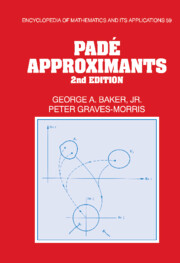Book contents
- Frontmatter
- Contents
- Preface
- Preface to the first edition
- 1 Introduction and definitions
- 2 Elementary developments
- 3 Padé approximants and numerical methods
- 4 Connection with continued fractions
- 5 Stieltjes series and Pólya series
- 6 Convergence theory
- 7 Extensions of Padé approximants
- 8 Multiseries approximants
- 9 Connection with integral equations and quantum mechanics
- 10 Connection with numerical analysis
- 11 Connection with quantum field theory
- Appendix: A FORTRAN FUNCTION
- Bibliography
- Index
6 - Convergence theory
Published online by Cambridge University Press: 29 September 2009
- Frontmatter
- Contents
- Preface
- Preface to the first edition
- 1 Introduction and definitions
- 2 Elementary developments
- 3 Padé approximants and numerical methods
- 4 Connection with continued fractions
- 5 Stieltjes series and Pólya series
- 6 Convergence theory
- 7 Extensions of Padé approximants
- 8 Multiseries approximants
- 9 Connection with integral equations and quantum mechanics
- 10 Connection with numerical analysis
- 11 Connection with quantum field theory
- Appendix: A FORTRAN FUNCTION
- Bibliography
- Index
Summary
Introduction to convergence theory: rows
This chapter is concerned with what is known about convergence of sequences of Padé approximants to complex functions.
For row sequences, de Montessus's theorem proves convergence for functions meromorphic in a disk, as explained in Section 6.2.
Diagonal sequences are the natural choice for meromorphic functions in the absence of further information. Simply because meromorphy of a function implies meromorphy of its reciprocal, the symmetric choice of diagonal approximants is natural, especially in view of the duality theorem. Paradiagonal sequences, [M + J/M] with J fixed and M → ∞, are an obvious generalization, usually motivated by the requirement of an asymptotic approximation of zJ as z → ∞.
Ray sequences of [L/M] Padé approximants with L = λM, λ fixed, are useful in special circumstances, and parabolic sequences, such as [M2/M], are worth considering sometimes. Hence interest settles on general sequences [Lk/Mk] which may be particularized to suit special needs. The most natural convergence theorems for general sequences of Padé approximants involve convergence in capacity, a difficult concept. Instead of attempting to prove pointwise convergence for a class of functions, the theorems prove that the region of bad approximation becomes arbitrarily small. In no way do these theorems imply pointwise convergence, but they do prove that the Padé method converges in a real sense in very general circumstances.
Recognizing that Padé approximants to meromorphic functions are simply rational approximations, another natural development is the notion of convergence of the function values on the Riemann sphere, which is treated in Section 6.4.
Information
- Type
- Chapter
- Information
- Padé Approximants , pp. 276 - 334Publisher: Cambridge University PressPrint publication year: 1996
